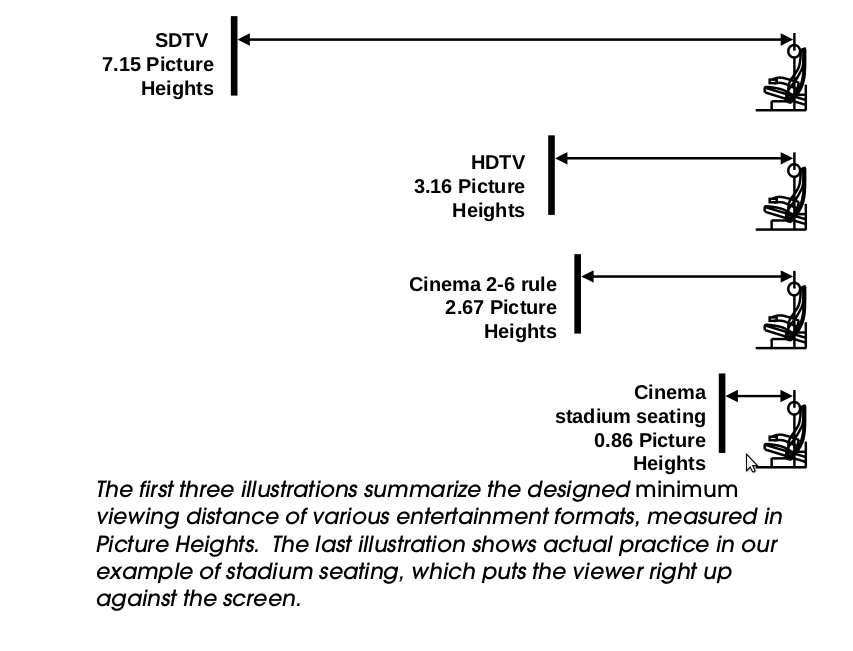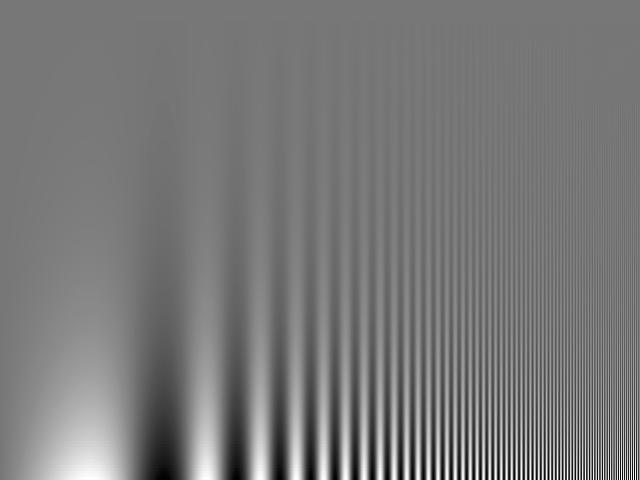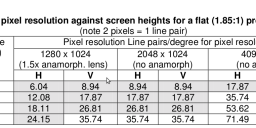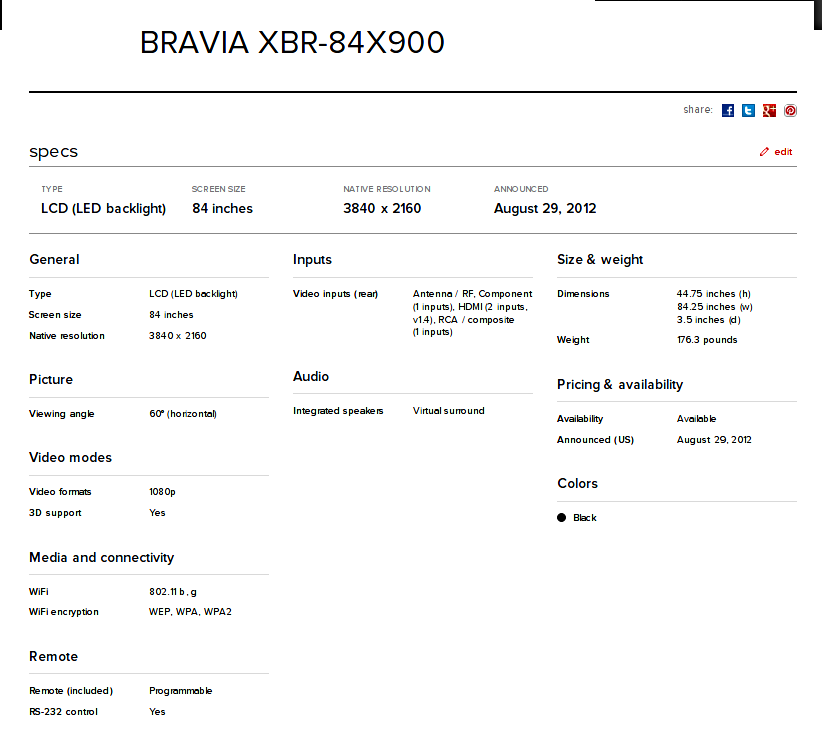
-
When a local cinema replaced their film projectors with only 2K instead of 4K, I was disappointed. Sony explains why.
Picture Height: the measure of viewing distance

When the standard definition television system was first launched in North America, engineers assumed that viewers would want to sit at a sufficient distance for the individual scanning lines that comprise the picture to blend into a visually seamless whole. In the days before pixels, these engineers figured on 60 horizontal scanning lines per degree. From this, they derived a standard viewing distance of 7.15 Picture Heights (PH). Studies by Bernard Lechner of RCA in the US and Richard Jackson at Philips Laboratories in Europe determined that actual viewing distance for standard definition TV is around 10 feet (3 meters).8 The screen size that corresponds to 7.15 Picture Heights at this distance is 28 inches diagonal. This roughly matches the larger CRT sizes of the standard definition era.
Movie theater design has been influenced by similar calculations. In the 1940s, the Society of Motion-Picture Engineers (SMPE) made a recommendation called the 2-6 rule.9 It proposed that theater auditoriums be designed with the nearest seats at two times picture width and the farthest at six times picture width. Using the Academy Aperture screen shape of the time, that translates to a minimum viewing distance of 2.67 Picture Heights.
When high definition television was first proposed, the design goal was to equal the performance of movie theaters. This dictated an increase in TV resolution sufficient to create the illusion of a seamless image at roughly three Picture Heights.10 (The actual figure is 3.16 Picture Heights.) This similarity to the 2.67 specification of old movie theaters is not a coincidence. It is by design.
Since the 1940s, just about everything in movie theaters has been transformed, including auditorium design. Through the 1990s, new theater designs moved to progressively wider-angle projection lenses, which suggests that seats became progressively closer to the screen.11 By 1994, viewing distances that had once been considered the minimum were now close to the maximum. The renamed Society of Motion Picture and Television Engineers (SMPTE) issued Engineering Guideline EG 18- 1994, which recommended that the screen subtend a minimum horizontal angle of 30 degrees for viewers in the back of the room. This corresponds to a distance of 3.45 Picture Heights (using the5 contemporary picture proportions of 1.85:1). EG 18-1994 proved to be a snapshot of best practices at the end of the era of sloped-floor auditoriums.
It was withdrawn in 2003 as inappropriate for the new era of stadium seating auditoriums, which bring the audience even closer. In stadium seating, the back of the house is about three Picture Heights from the screen while the closest seats are less than one Picture Height away.
From Sony - Does 4K really make a difference? http://pro.sony.com/bbsccms/static/files/mkt/digitalcinema/Why_4K_WP_Final.pdf
-
First, thank you for posting the link to that document - very interesting information.
Another reason for 4k is 3D. I watched a 3D movie in a Sony-equipped 4k theater three weeks ago. The ads that ran before the movie all seemed to be in 2k, followed by a 4k ad for the Sony projection system used in the theater and some 4k trailers - very nice, the difference was noticeable.
But since the movie itself was in 3D, this was done by projecting 2k images separately for the left and right eye simultaneously, which is an improvement over the old 3D system.
-
ehm usually 3d movie are two 2k images for left and right, only at home, with passive screen you have half of resolution, at theather every 3d projection is 24 for left, 24 for right, and polarized filter on projector and eyesglasses allow you to see 24 full 2k frame for both of eyes... this for all 3d 2k projector present from in actual theathers.
-
ehm usually 3d movie are two 2k images for left and right, only at home, with passive screen you have half of resolution
You mean passive 3D TV? Idea of half of resolution is not true, image is combined by brain in very early stages, so you have full resulution. Difference can be noticeable for some hearly horizontal lines and some textures.
Btw bigges problem with theater and active TVs is not resolution, it is brightness. And normally it is too low.
-
All I know is I saw Prometheus (2D version) twice (dont ask!).
Once on a old cinema screen (local fleapit) and again on a newly fitted Sony 4k screen at Vue. 4k looked awesome when it was real locations but when it got to sets and makeup FX it really showed the flaws more than the standard screening did. Also you could see the difference from the trailers beforehand. There is a visible difference.
-
When we're watching a movie in HDTV mode and usual distance, a small bird flying from lower left to upper centre flaps its way through a thousand pixels within and 10 frames in the half-second or so. Our eyes follow its smooth movement.
When we're sitting in a modern cinema, we need to turn our head to follow that bird. In 2K, we see each frame flicker. The illusion of movement is broken. In 4K, it's smoother.
Moore's law still applies. Higher res isn't going to go away - nor are higher frame rates.
-
When we're sitting in a modern cinema, we need to turn our head to follow that bird. In 2K, we see each frame flicker. The illusion of movement is broken. In 4K, it's smoother.
I think you have big logic problems here. It can be smoother at 48fps or 60fps. 4K resolution won't make motion smoother.
-
But 4K offers more positions for the bird to occupy. Spatial rez counts as well for smooth motion to a smaller degree.
I don't follow any logic here. Zero.
-
I don't follow any logic here. Zero.
It's called antialiasing. A blocky bird-shape doesn't motion-blur over 24 pixels as well as it does over 48 pixels.
What Sony is talking about here is cinema seating design. Remember 20 years ago when you got to a Saturday matinee film late and had to sit in the cheap seats at the front? As a kid I'd crane my neck during the B&W serial as Batman juddered his way across the screen...
Well, all the seats are closer to the screen than we used to put up with. 2K projections work well for skin-tones and nature shots but show stepping with buildings and furniture.
An Aussie made a 35mm surfing film when DigiBeta came out. He got away with it by being careful with the horizon and any other straight lines.
Audiences have become discerning. If they have to pay for an evening out, they expect better than what they have at home.
-
You want to mix different things. Motion in 4K will be same.
I suggest to use scientific approach, and make absolutely controlled experiments, if you so want to prove it.
-
Tone down your comments. And make normal scientific experiment.
-
What did your last slave die of?;-)
Where I live, that's what we say here to someone asks us to something a little over the top:
what did your last slave die of? (idiomatic, humorous) Used to indicate that someone is being bossy and/or demanding, usually to an unreasonable extent. http://en.wiktionary.org/wiki/what_did_your_last_slave_die_of
Now, to get real here, we're talking about being too close to screens. They say Digibeta's surfing movie pixels were 5cm across when projected: too big to be viewed close up but OK from a distance.
Everybody's had that experience of sitting very close to a screen (or even standing behind it) as images flicker across it. They can seem to jump a foot at a time. You can throw away the rule book about the illusion of motion when each 24th of a second of movement requires its own eye movement. You can forget about the illusion of a picture when the pixels are too big.
Now, I doubt if more resolution is going to fix that degree of stutter. But it's been my experience that higher resolution (as in a feature film) helped my eyes make more sense of it than the Ektachrome 64 trailers or newsreels we used to get before the feature.
And no, I don't think it's a big issue. It's off-topic regarding the need for 4K cinema screens.
And no, @Vitaliy_Kiselev, I wouldn't know where to start regarding scientific experiments about all this.
-
I always felt if anything, that higher resolution made stutter more apparent because you have more pixels changing per frame making the change more apparent.
Regarding 4k and 2k, I feel that if you can see the difference between a 9 megapixel still picture and a 2 megapixel still picture, you should be able to see the difference between 4k and 2k. Motion and closeup shots can mask resolution deficiencies, but films often contain wide landscapes and shots with little motion. That said, I think 2k will be enough for awhile.
I also think it's important to distinguish true 1080p from DSLR 1080p. Because of these DSLR's, people are starting to think 1080p looks like what's coming out of their 7D and 5D when in fact it's more like 720p (and not even that). The GH2's 720p mode apparently outresolves the 1080p mode on the Canon 7D (refer to Mark's video below).
This means the 7D's 1080p mode offers less than half of its implied resolution. To me, this is very misleading and a borderline scam. By this standard, what's stopping Canon from making their 4k EOS 1D C only resolve the resolution of the hacked GH2 in a 4k container? Maybe Red should make a firmware update for the Epic that uprezes their footage to 8k and claim the Epic now has the highest resolution in the digital cinema market. Of course, this is where the differences between the consumer and pro market start to become apparent.
-
higher resolution made stutter more apparent because you have more pixels changing per frame making the change more apparent
I used to disagree with this idea - stuttering is often a shutter problem and slowing shutter speed or applying motion-blur fixes it.
But now (see 24P stutter thread) I get the feeling @Driftwood may be onto something re AVCHD's "tweening." And yes, if we are getting surprise i-frames contradicting the predictive frames - well, yes, theoretically the blurrier, lower-res the irregular frame is the better!
The best way to test the theory is to go to the movies. At present lots of the ads and pre-feature, locally produced stuff is likely to be shot in [AVCHD?] 2K. @Edwardm and @Mimirsan say these look different in 4K projection than the 4K source of the feature.
Which brings me to this quoted and actual resolution thingy:
it's more like 720p (and not even that)
There's resolution as in graininess and then there's resolution as in what's in a 1x1 pixel box. A movie cinema might help here, but it's still a good idea to zoom into a couple of stills to see what's going on: eg genuine 1080 individual pixels in a column, or clever interpolation of a mere 720, or usual anti-aliasing or plain old "too blurry to see"ness.
Mark's video is the type of comparison I'd like to see more often. Just you can't make a silk purse out of a sow's ear, neither can you create a flower-pattern on your bathroom floor with just 9 coloured tiles,nor can you display a slightly-off-horizontal straight line, a building horizon etc.
On the other hand, when you want to sell your camera, the best way to show off its capabilities is to demonstrate its rendition of skin-tones and nature, like the Bondi Beach Digibeta surfing success.
One thing we have learned is that viewers learn to appreciate higher resolutions and know the difference.
Kodak's tests with Vision 3 stocks show that the silver halide emulsion continues to resolve detail when digitized at 6K. Try and sell cinema audiences that 2K experience and they'll soon find their home cinema looks as good.
-

USAF 1951 resolution test target, showing diminishing line spacing on groupings. This is used to visually ascertain resolution in optical systems or visual systems.
Full size download at http://www.luxgenix.com/tool/USAF1951cropped.zip
Full size EIA 1956 Resolution Chart (PDF): http://www.luxgenix.com/tool/EIA_1956_resolution_chart.pdf
-
More interesting data regarding screen distances:

Notes:
Grey cells in the table indicate situations where pixels resolution is less than the limit of visual acuity. Limit of visual acuity is about 30 lp/degree.
Normal theatre places the front row about 1 picture height back from the screen.
“Best viewing” is normally 2 to 2.5 picture heights back from screen.
Anamorphic lens provides anisotropic pixel resolution in 1280 x 1024 mode – i.e. higher resolution vertically than horizontally.
Perceived resolution in an anisotropic situation is approximately the average of horizontal and vertical resolutions.
From this table, we can see that even a 4K projector does not satisfy the HVS requirement for simple limiting resolution until the viewer is almost 2 screen heights away from the screen.
Testing visual impression of resolution and contrast:

Contrast Sensitivity Function pattern showing that visual sensitivity to contrast is highest at lower resolutions than the threshold of acuity.
This is noted by the envelope of modulation that looks (sort of) like a Gaussian curve. If the pattern is observed from close up, the Gaussian shape moves right, if viewed from further away, it moves left. The peak on this curve represents the spatial frequency where contrast discrimination is most sensitive. (View from at least 5’ away on a 17” monitor with image at 150%)
From Matt Cowan 2002, Digital Cinema Resolution – Current Situation and Future Requirements (see PDF)
Note: This 2001 document also includes some outdated references to the resolution of film itself with respect to of a film media release print. This was produced with respect to a full film workflow, without digital intermediate, assuming degradation over multiple copy generations . Back then, film stocks were more grainy and cinema release digitization was only 2K.
The rest of the document is mostly applicable to today's screen sizes and viewer perception.

 SpatialFrequencyMotion.jpg640 x 480 - 19K
SpatialFrequencyMotion.jpg640 x 480 - 19K
 ScreenshotPixelResolutionAgainstScreenHeights.png1194 x 381 - 54K
ScreenshotPixelResolutionAgainstScreenHeights.png1194 x 381 - 54K
 Technical Issues in Cinema Resolution.pdf1M
Technical Issues in Cinema Resolution.pdf1M -
Is Sony announcing a 4K Blu-Ray replacement?
from Red Shark News
The XBR-84X900 has a three chipset solution that incorporates Sony’s proprietary and critically- acclaimed X-Reality PRO picture engine and upscales video content to near 4K quality. That’s right, the programming you currently enjoy, whether from cable/ satellite or even your favorite movies on Blu- ray Disc, will be upscaled to an even higher resolution. The thousands of Blu-ray Discs already published have instantly gone from looking good to looking phenomenal. Secondly, while 4K Ultra HD broadcasts aren’t the norm yet, you have already been viewing the first broadcast applications. At one of its NFL games each week, Fox Sports utilizes a Sony 4K F65 Cinealta camera to capture footage for instant replays. When the network enlarges the video to get an up close look at say a receiver tiptoeing a sideline, the video naturally loses resolution, common to enlarging any photo or video. But, with 4 times the resolution of Full HD, 4K has more than enough resolution to spare, and losing half still provides the best.
Sony makes 4K projectors for the home and cinema, 4K upscaling Blu- ray Disc players, and 4K Ultra HD televisions. Sony also makes 4K professional cameras for production studios. Plus, Sony has its own studio – Sony Pictures Entertainment (SPE) – that turns out 4K production every day. Do you really think we’d leave our 4K Ultra HD TV customers hanging? In the next couple of weeks, the XBR-84X900 television will ship to customers who placed pre-orders since the product introduction in September. As an extra bonus, included free with the purchase will be the world’s first 4K Ultra HD delivery solution, complete with pre- loaded, native 4K entertainment. Not some goofy 4K content shot as a demo. I’m talking full length feature Hollywood productions, and available exclusively to purchasers of Sony’s 84” 4K Ultra HD TV. I know, cool, right? Okay, I can’t say anything more right now, ‘cause my boss probably already thinks I’ve written too much. But, stay tuned for an announcement sometime after turkey day.
http://www.redsharknews.com/distribution/item/233-did-sony-just-reveal-the-next-blu-ray
-
It is an exaggeration to presume 84", 4K screens will be purchased only by rich consumers. This unit is large enough for a small cinema, especially in a museum/corporate/educational/airport environment. My clients will be interested in the XBR-84X900 as an alternative to existing installations.
I will start to position myself to develop media for a cheaper, XBR-84X900 straight away.


 BraviaXBR-84X900.png822 x 729 - 61K
BraviaXBR-84X900.png822 x 729 - 61K -
I saw Prometheus on a Sony 4K in 3D (optimal presentation setup, viewed "as intended" by the filmmakers), and it looked fabulous.
-
From what I gathered the whole prometheus was filmed on red and the files were reduced to 2k because all the CGI was done in 2k because it would cost 4 times more to render. So most probably people saw uprez 2k version.
-
Where did you get that info? Just wondering.
Edit: checked IMDB, you're right. "2K Digital Intermediate"
-
@NOMAD "Of course fps are more important. But 4K offers more positions for the bird to occupy. Spatial rez counts as well for smooth motion to a smaller degree."
The bird will not have more positions to occupy because how many positions this bird has is dictated by the frame rate, not the spatial resolution. If you have a 1920x1080 screen vs 4K or even 400000K and the frame rate is the same each time, let's say 24fps, then in one second you'll see no more than 24 positions of a bird, no matter what the resolution is. Another example: let's imagine it takes 1 second for a bird to fly across the screen horizontally. Then even in HD resolution (1920 x 1080) you would need 1920fps to actually start getting close to running out of your spatial resolution and bird positions. In 24fps, 48fps, 60fps you are not even getting close to a situation where spatial resolution affects the motion rendering.
-
"2K Digital Intermediate"
I have found too many instances of IMDB using that exact phrase. I doubt it's always factual. In fact, IMDB's Technical Details section itself gets second-billing to the story and the stars. I'd like to know if there's any movie site anywhere near as comprehensive as IMDB but with better tech talk.
Howdy, Stranger!
It looks like you're new here. If you want to get involved, click one of these buttons!
Categories
- Topics List23,992
- Blog5,725
- General and News1,354
- Hacks and Patches1,153
- ↳ Top Settings33
- ↳ Beginners256
- ↳ Archives402
- ↳ Hacks News and Development56
- Cameras2,367
- ↳ Panasonic995
- ↳ Canon118
- ↳ Sony156
- ↳ Nikon96
- ↳ Pentax and Samsung70
- ↳ Olympus and Fujifilm101
- ↳ Compacts and Camcorders300
- ↳ Smartphones for video97
- ↳ Pro Video Cameras191
- ↳ BlackMagic and other raw cameras116
- Skill1,960
- ↳ Business and distribution66
- ↳ Preparation, scripts and legal38
- ↳ Art149
- ↳ Import, Convert, Exporting291
- ↳ Editors191
- ↳ Effects and stunts115
- ↳ Color grading197
- ↳ Sound and Music280
- ↳ Lighting96
- ↳ Software and storage tips266
- Gear5,420
- ↳ Filters, Adapters, Matte boxes344
- ↳ Lenses1,582
- ↳ Follow focus and gears93
- ↳ Sound499
- ↳ Lighting gear314
- ↳ Camera movement230
- ↳ Gimbals and copters302
- ↳ Rigs and related stuff273
- ↳ Power solutions83
- ↳ Monitors and viewfinders340
- ↳ Tripods and fluid heads139
- ↳ Storage286
- ↳ Computers and studio gear560
- ↳ VR and 3D248
- Showcase1,859
- Marketplace2,834
- Offtopic1,320











